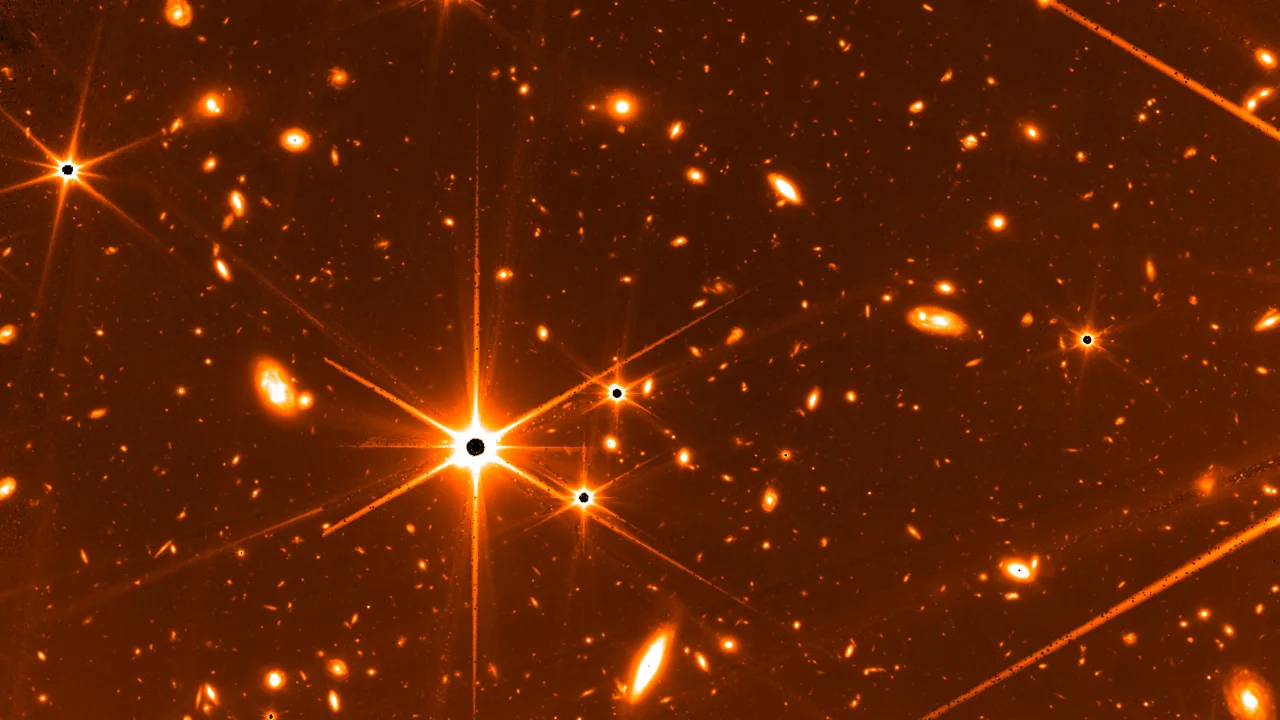
Canadian camera on Webb dazzles us with an out-of-this-world preview
This is just from the camera that aims the telescope, so imagine what the upcoming 'wow' images are going to reveal!
We're just days away from seeing the first full-colour images from the James Webb Space Telescope. The team has released a new teaser picture taken by a Canadian camera on board the telescope, and it's already blowing our minds.
In May 2022, the Webb telescope tested its ability to 'roll', similar to how a plane rolls during flight. The telescope controlled this maneuver using the Fine Guidance Sensor, a camera built by the Canadian company Honeywell Aerospace and supplied by the Canadian Space Agency. During this test, the FGS took more than 70 images over a total of 32 hours, keeping Webb precisely aimed at a star in our galaxy known as HD147980.
When the mission team stacked these images, the result was one of the deepest images of the universe we've seen so far.
This false-colour mosaic combines 72 exposures from the Fine Guidance Sensor on JWST, taken over 32 hours in May 2022. In the field of view are roughly two dozen foreground stars, easily picked out due to the six diffraction spikes that radiate from each. Every other bright spot in the image is a galaxy! Credit: NASA, CSA, and FGS team
According to NASA: "When FGS' aperture is open, it is not using color filters like the other science instruments — meaning it is impossible to study the age of the galaxies in this image with the rigor needed for scientific analysis. But even when capturing unplanned imagery during a test, FGS is capable of producing stunning views of the cosmos."

This closeup of the FGS composite zooms in on a region of distant objects. With the image contrast adjusted, the numerous galaxies in the background are revealed. Credit: NASA, CSA, and FGS team; inset added and modified by Scott Sutherland
"When this image was taken, I was thrilled to clearly see all the detailed structure in these faint galaxies," Neil Rowlands, the Fine Guidance Sensor program scientist at Honeywell Aerospace, said in a NASA Webb blog post.
"Given what we now know is possible with deep broad-band guider images, perhaps such images, taken in parallel with other observations where feasible, could prove scientifically useful in the future," Rowlands explained.
CANADA KEEPS WEBB ON TARGET
Partnering with NASA and the ESA on Webb, the Canadian Space Agency provided two essential instruments to the space telescope.
The Fine Guidance Sensor (FGS) is possibly the most crucial instrument for Webb's mission, allowing the telescope to:
use the stars as cosmic reference points to determine its position in space,
pinpoint the celestial targets astronomers want to observe,
track moving targets across the backdrop of space, and
maintain a steady, high-precision lock on its celestial targets.

Canada's stellar navigator on the James Webb Space Telescope. Credit: Canadian Space Agency
Integrated into the same unit as the FGS is the second Canadian instrument on Webb, the Near-Infrared Imager and Slitless Spectrograph, or NIRISS.
Working alongside Webb's other instruments, NIRISS will contribute to our understanding of the universe. Most remarkably, though, this instrument will also allow astronomers to closely study exoplanets — alien worlds orbiting distant stars.
EXCITEMENT BUILDS FOR THE BIG REVEAL
The first full-colour images and spectrographic data from Webb are scheduled to be released just days from now.
During a June 30 media teleconference, NASA Administrator Bill Nelson said the telescope was going to "give humanity a new view of the cosmos," and that one of the upcoming images is "the deepest image of our universe that has ever been taken."
In the same teleconference, Thomas Zurbuchen, Associate Administrator for the Science Mission Directorate at NASA, said they will also share Webb's first exoplanet spectrum. This type of data can reveal the composition of the exoplanet's atmosphere and potentially whether conditions there are favourable for life as we know it.
For those who have already seen these images, it was an emotional experience.
"What I have seen just moved me..." NASA Deputy Administrator Pam Melroy said during the teleconference. "As a scientist, as an engineer, and as a human being."
The handful of images that Zurbuchen had seen at the time brought back the same feeling of awe he had experienced as a graduate student, upon seeing some secret of the universe, something no one had known about before, revealed to him for the first time.
"I got emotional," he said. "It's really hard to not look at the universe in a new light and not just have a moment that is deeply personal, in a way that, frankly, surprised me."
See Webb's first full-colour images live as they are presented one by one, at 10:30 a.m. EDT, on Tuesday, July 12. At the same time, they will also become available on the NASA website for us to marvel at and experience that same sense of awe.
"On July 12, what we will see is not just an image," Zurbuchen said. "It's a new world view of nature giving away secrets that have been there for many decades, centuries and millennia."











